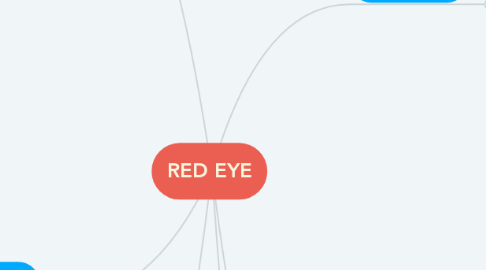
1. Acute Glaucoma
1.1. History
1.1.1. Obstruction in outflow of aqueous humor
1.1.1.1. IOP >23mmHg
1.1.2. Angle closure
1.2. Symptoms
1.2.1. Eye pain
1.2.1.1. Discharge
1.2.2. Headache
1.2.3. Corneal edema
1.2.3.1. Iridescent vision
1.2.4. No photophobia
1.3. Diagnosis
1.3.1. Applanation tonometry
1.3.2. Visual field exam
1.4. Treatment
1.4.1. Acetazolamide
1.4.2. Hyperosmotic oral solution
1.4.3. Topical ocular hypotensive
1.4.4. Laser iridectomy
1.4.5. Glaucoma filtering surgery
2. Keratitis
2.1. History
2.1.1. Infectious
2.1.1.1. Bacterial
2.1.1.1.1. Pneumococcus
2.1.1.1.2. Pseudomonas
2.1.1.2. Viral
2.1.1.3. Fungal
2.1.1.4. Acanthamoeba
2.1.2. Non-infectious
2.1.2.1. Recurrent epithelial erosion
2.1.2.2. Foreign body
2.2. Symptoms
2.2.1. Eye pain
2.2.2. Mucoid to mucopurulent discharge
2.2.3. (+) lesion on central cornea
2.2.3.1. Blurring of vision
2.3. Diagnosis
2.3.1. Corneal scrapings
2.3.2. Gram stain
2.3.3. Culture studies
2.4. Treatment
2.4.1. Topical antibiotics
2.4.2. Keratectomy
3. Entropion/Trichiasis
3.1. History
3.1.1. Elderly
3.1.1.1. Misdirected lashes
3.2. Treatment
3.2.1. Removal of misdirected lashes
3.2.2. Cautery of eyelash roots
3.2.3. Eyelid surgery
4. Conjunctivitis
4.1. Infectious
4.1.1. Bacterial
4.1.1.1. History
4.1.1.1.1. Contact lens
4.1.1.1.2. URTI
4.1.1.1.3. Steroid eye drop use
4.1.1.1.4. Trauma
4.1.1.2. Symptoms
4.1.1.2.1. Unilateral
4.1.1.2.2. Acute onset
4.1.1.2.3. Mucopurulent discharge
4.1.1.2.4. Erythema
4.1.1.2.5. No eye pain
4.1.1.2.6. No blurring of vision
4.1.1.3. Diagnosis
4.1.1.4. Treatment
4.1.1.4.1. Antibiotic eye drops
4.1.1.4.2. Oral antibiotics
4.1.2. Viral
4.1.2.1. History
4.1.2.1.1. URTI
4.1.2.1.2. Fever
4.1.2.1.3. Sore throat
4.1.2.1.4. Exposure to sore eyes
4.1.2.1.5. 2 days to 2 weeks
4.1.2.1.6. Conjunctival scrapings
4.1.2.2. Symptoms
4.1.2.2.1. Acute onset
4.1.2.2.2. Watery discharge
4.1.2.2.3. Unilateral then becomes bilateral
4.1.2.3. Treatment
4.1.2.3.1. Hand washing
4.1.2.3.2. Avoiding direct contact to eye discharge
4.1.2.3.3. No treatment
4.1.2.3.4. Antibiotic eye drops for secondary bacterial infection
4.1.2.3.5. Mild steroid drops for inflammation
4.2. Non-infectious
4.2.1. Allergic
4.2.1.1. History
4.2.1.1.1. Chronic/recurrent
4.2.1.1.2. Vernal/seasonal
4.2.1.1.3. Hay fever
4.2.1.1.4. Atopic keratoconjunctivitis
4.2.1.2. Symptoms
4.2.1.2.1. Watery, mucoid, stringy discharge
4.2.1.2.2. Itchiness
4.2.1.2.3. Papillary rxn of upper bulbar conjunctiva
4.2.1.2.4. Allergic shiners
4.2.1.3. Treatment
4.2.1.3.1. Removal of environmental triggers
4.2.1.3.2. Cold compress
4.2.1.3.3. Mast cell stabilizers
4.2.1.3.4. Antihistamine eye drops
4.2.1.3.5. Short topical steroids
4.2.2. Dye eye/ Keratoconjuctivitis sicca
4.2.2.1. History
4.2.2.1.1. Elderly
4.2.2.1.2. Inability to close eyelids
4.2.2.1.3. Meibomitis
4.2.2.2. Diagnosis
4.2.2.2.1. Shirmers testing
4.2.2.3. Treatment
4.2.2.3.1. Aqueous tear replacement
4.2.2.3.2. Artificial tears
4.2.2.3.3. Punctual occlusion
4.2.3. Contact lens use
4.2.3.1. History
4.2.3.1.1. Decreased O2 supply to cornea
4.2.3.2. Treatment
4.2.3.2.1. Rest
4.2.3.2.2. Antibiotic eye drops
4.2.4. Foreign body
4.2.4.1. History
4.2.4.1.1. Sudden onset
4.2.4.1.2. Trauma
4.2.4.2. Symptoms
4.2.4.2.1. Eye pain
4.2.4.3. Treatment
4.2.4.3.1. Topical antibiotics
4.2.4.3.2. Eye patching
5. Uveitis
5.1. History
5.1.1. Idiopathic
5.1.2. Vogt-Konayagi-Harada
5.1.3. Behcet's
5.1.4. Collagen vascular disease
5.1.5. Herpes virus
5.1.6. Mycobacterium TB
5.2. Symptoms
5.2.1. Discharge
5.2.2. Photophobia
5.2.3. Posterior synechia
5.3. Treatment
5.3.1. Steroids
5.3.2. Immunosuppressive agents
6. Episcleritis
6.1. History
6.1.1. collagen vascular disease
6.2. Symptoms
6.2.1. Severe eye pain
6.2.2. No blurring of vision
6.3. Treatment
6.3.1. Topical steroids
6.3.2. NSAIDs

